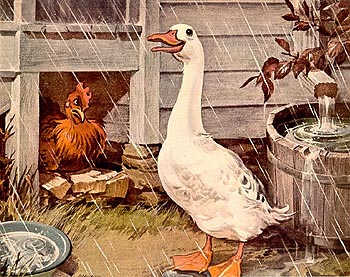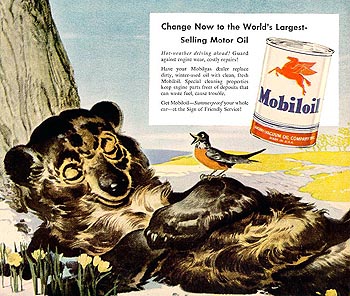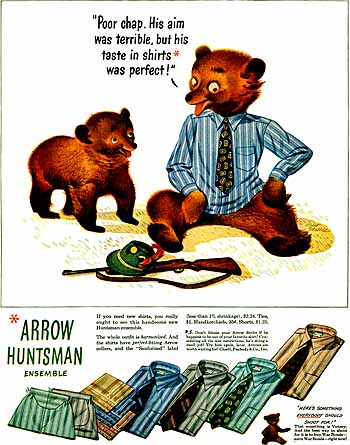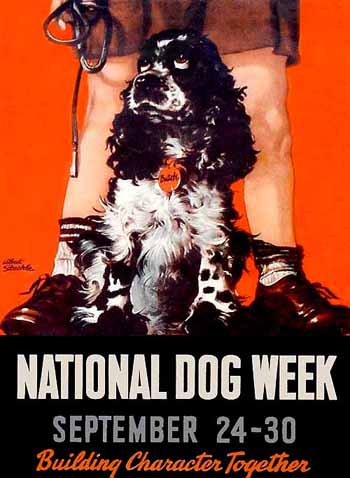
|
Copyrighted Material -CLICK for information |
|
Back |
 |
Albert Staehle
(1899 - 1974)
By Sharon Damkaer |
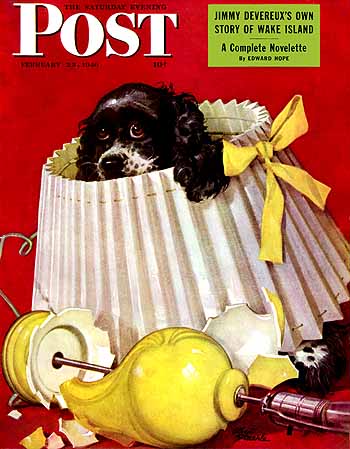
Trouble in Doggie-Land. Butch, the calamitous Cocker on the loose! Saturday Evening Post cover (23 February 1946) |
| The Early Years
Albert Staehle was one of America's most popular illustrators from the late 1930s into the mid-1960s. Staehle came by his artistic abilities naturally since his father and his maternal grandfather were artists.
Albert studied art at The Wicker School in Detroit and the Art Students League of New York and took other art courses regularly afterward to improve his artistic skills. In 1937 Staehle won a poster competition with his illustration of a matronly cow feeding her calf with a bottle of Borden's milk. Later the Borden Company was to develop this theme with its long-running Elsie the Cow campaign. Staehle's winning poster was such a hit it brought him an instant reputation as an animal expert. Staehle designed one of the most prized posters of the 1939 New York World's Fair. His painting contrasts bright colors in the background showing the Trylon-Perisphere and fireworks in the sky with darker colors for the people in the foreground, including the central figure of an attractive, officially uniformed lady standing with one arm raised in a wave. |
|
Original painting, left, and finished Fleetwood cigarette ad, right (1943) 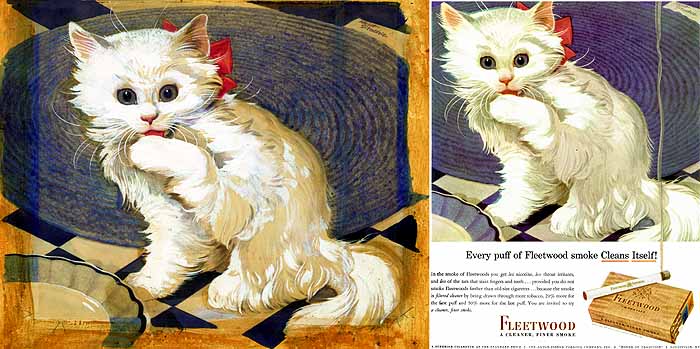 |
| The Poster Artist Staehle's technique for preparing his poster art was described in the January 1943 issue of American Artist magazine: "He takes the sketch from his folio and quickly walks across the room with it, exposing it to the client's view for a few seconds. Then he asks the client to describe the poster which, if properly designed, should require but that brief interval to convey its message. "Staehle makes his first sketches for posters 9x18 inches. He puts these into a projecting machine which reduces or enlarges as desired. First he reduces the design to 4 inches. At that small scale certain factors in the design are more easily judged. After making desired corrections the sketch is enlarged to 36 inches, the size at which the final drawing will be made. This may lead to still further changes. "In the final rendering (18x36 inches) Staehle lays in his color with transparent colored inks. Later he overlays these inks with tempera paint when he wishes to make modifications which require the use of opaque color. "The posters Staehle likes best are those with little or no background.... Usually he focuses attention upon the animal's head, giving it as much expression as possible and subordinating the rest of the figure to this dominant interest. The head is usually caricatured by enlargement of certain anatomical features, especially the eyes which are greatly enlarged and animated with significant intent." |
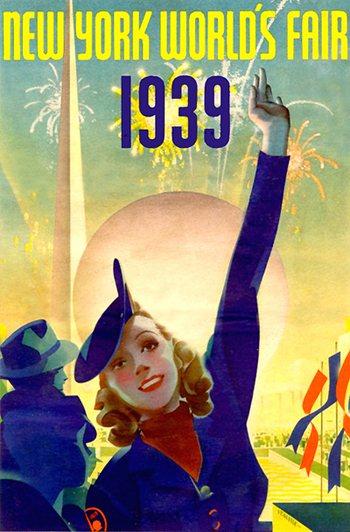
Promotional Poster for New York World's Fair (1939) |
|
Shell Oil (1939) |
| Animal Lover Staehle used live animals as his models, often surrounding himself in his studio with various animals to help him capture their moods. He also worked from photographs and at the age of 51 he met his future wife Marjory Houston Staehle when he hired her to photograph some of his models. The couple had four daughters. |
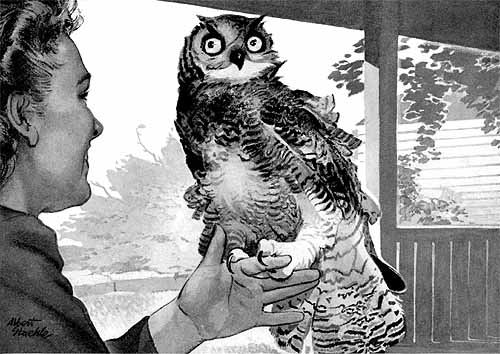
Staehle did Saturday Evening Post covers, but also story art (5 Sept 1944) |
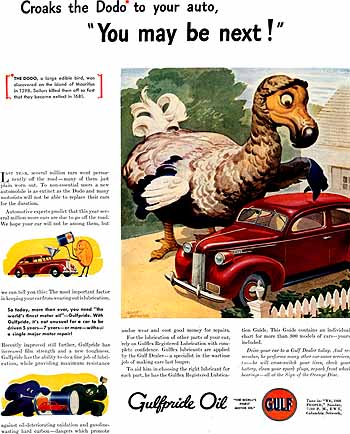
Gulfpride Oil (1943) |
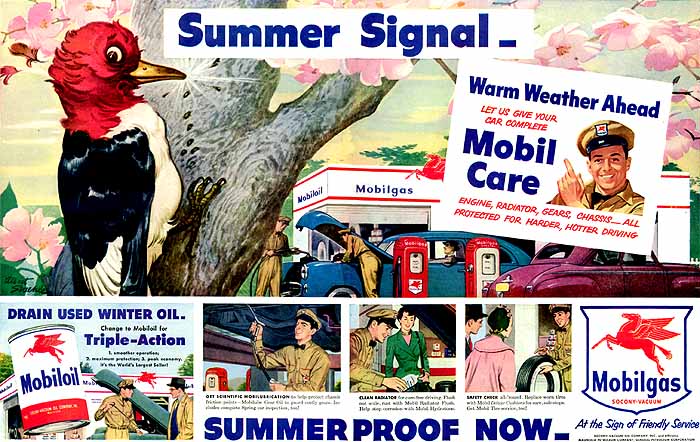
Mobil Gas (1950) |
|
A bear's serenaded siesta (above) for MobilOil (year unknown) |
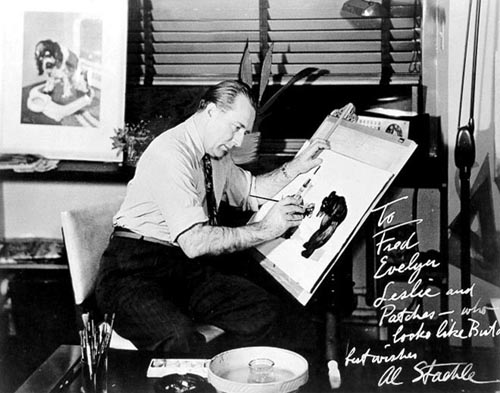
The artist at work at his drafting table (note Butch checking out his weight) |
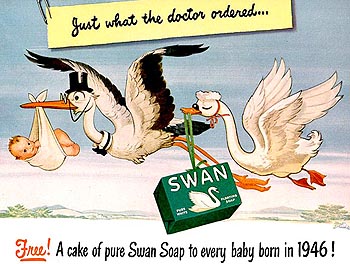
Swans by Staehle, Babies by Louise Rumely (1946) |
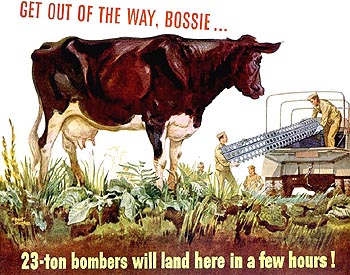
Staehle was capable of war-time realisim (1942) |
|
Arrow Shirt (1944) |
| In Demand Staehle was eagerly sought by advertisers for his billboard artwork. He was honored with the prestigious Kerwin H. Fulton medal for Achievement of Art in Outdoor Advertising for 1938, 1939, and 1940, and he also won awards from the Chicago Outdoor Advertising Association and the Art Directors Clubs of New York and Philadelphia. The artist's animal illustrations appeared in leading magazines of the day. He created the swan for the Swan Soap ads and colorful cats for Carter's Ink in the 1940s. |
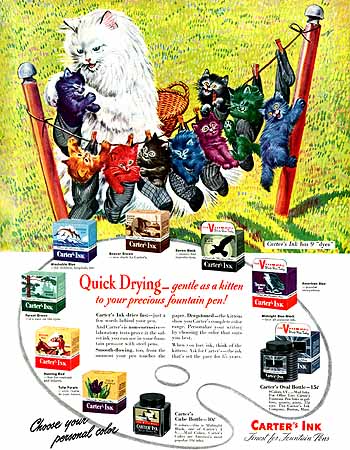 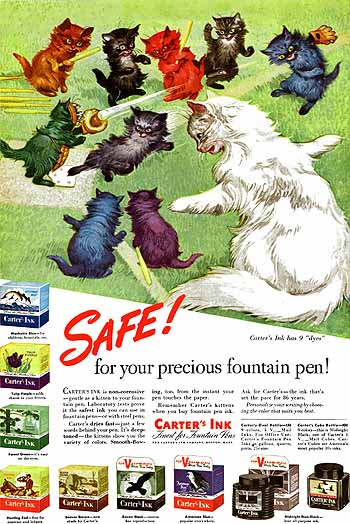
Technicolor Kitties! left (1943) and right (1944), two of Staehle's ingenious colorful cat ads for Carter's Ink. Nine colors= Nine Lives. |
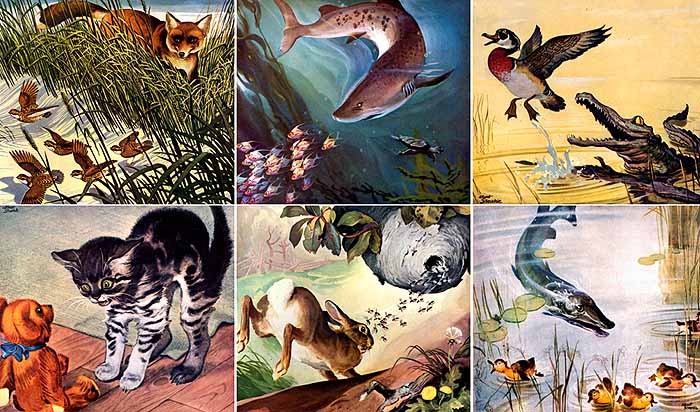 |
|
A series of Staehle illustrations for Imperial Whiskey ads (see montage below) appeared in LIFE and other magazines nearly every month in 1943 and 1944 depicting various animals, both domestic and wild. Other companies that used Staehle's artwork in their magazine advertising included the Barrett Division (Allied Chemical & Dye Corp.), Clay Tile, Fleetwood Cigarettes, Mobiloil, Pard Dog Food, Schaefer Beer, Shell Oil, Arrow Shirts, and Western Electric. Some of the companies Staehle did billboard advertising for included Amoco Tires, Atlas Battery, Atlas Tires, ESSO Gasoline (Standard Oil of New Jersey), Ford Motors, and Standard Service. In 1944, the Wartime Advertising Council and the U.S. Department of Agriculture's Forest Service asked Staehle to help them design a poster for their fire prevention campaign of 1945. Smokey Bear was created with Staehle's first poster showing the bear dressed as a ranger pouring water on an open campfire. Staehle also designed the next two Smokey posters for the 1946 and 1947 campaigns. |
|
Butch: National Dog Week Poster (1950) |
| Butch The artist's career focus changed dramatically when the Saturday Evening Post asked him to illustrate a dog cover for the magazine. Staehle's first Post cover appeared on the February 19, 1944 issue and showed a black and white Cocker Spaniel named "Butch" chewing up a book of wartime rationing stamps. The magazines sold out quickly and mail poured in to defend the mischievous puppy; some folks even sent rationing stamps to replace those Butch had appeared to destroy. Staehle used different Cocker puppy models for his first few Post covers, but realizing his illustrated Butch's growing popularity, he soon purchased his own puppy born in June 1944. Staehle registered the puppy with the American Kennel Club as "Cover Boy Butch," and thus began a successful partnership that was to run for nearly 20 years. Butch Junior, born in November 1950, assumed modeling duties for Staehle when he was old enough. |
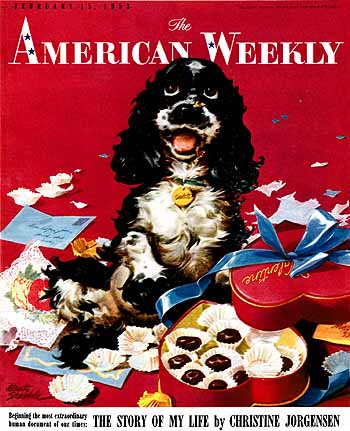
American Weekly (1953) |
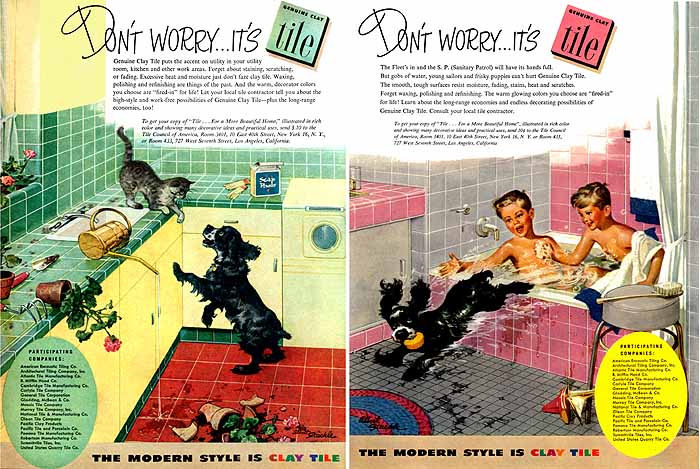
Clay Tile (1951) |
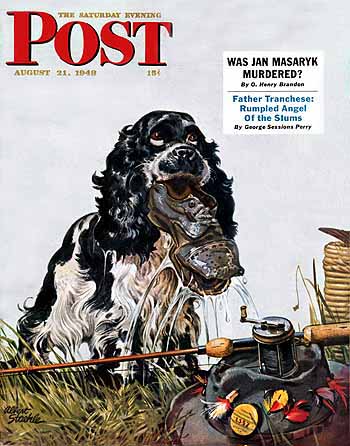
Saturday Evening Post (1948) |
|
Staehle's Butch appeared on 25 covers for the Saturday Evening Post in the 1940s, 30 covers for the American Weekly magazine in the 1950s, and on calendars, playing cards, and ink blotters from 1949 into the mid-1960s for Brown & Bigelow of St. Paul, Minnesota. A few of the same illustrations that appeared first on American Weekly covers were also sold to a Dutch magazine and the Canadian Star Weekly. Staehle copyrighted his Butch illustrations and sold only one-time use of them.
As Butch's popularity grew, he was immortalized in figurines by Hagen-Renaker Potteries of California and Goebel of West Germany; in stuffed toys by Atlas Toy Manufacturing Corp. of New York and Steiff of Germany; and in a coloring book and jig-saw puzzles produced by Saalfield. Butch was also in demand as a poster boy and both Butch Cockers made numerous public appearances with Staehle to raise money for various worthy causes. Staehle put Butch on the 1950 National Dog Week poster; the artist also designed the 1954, 1955, and 1956 NDW posters showing other dog breeds. Butch appeared in 1956 on a poster for the U.S. Navy encouraging re-enlistment; this earned him the honor of being sworn in as an official Navy mascot, a source of pride for his artist-master. Staehle was grateful to Butch for bringing him his greatest success as an artist. The demand for illustrators in the print media declined with the increasing use of color photography and the rise of television advertising in the 1960s. In his final years, Staehle gained a new audience for his artistic talents when he turned to painting people's portraits. |
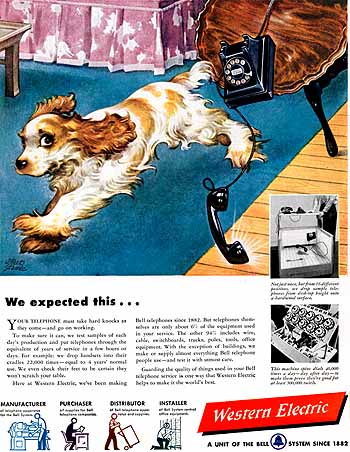
Western Electric (1948) |
|
© Sharon Giese Damkaer, 2003.
Sharon Damkaer's book Albert Staehle and Cover Boy Butch: A Biography and Collectibles Guide |
